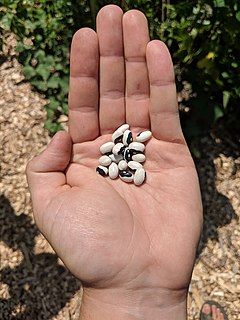
A bean is the seed of one of several genera of the flowering plant family Fabaceae, which are used as vegetables for human or animal food. They can be cooked in many different ways, including boiling, frying, and baking, and are used in many traditional dishes throughout the world.
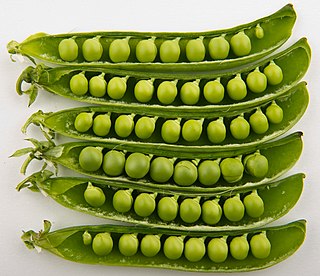
The pea is most commonly the small spherical seed or the seed-pod of the pod fruit Pisum sativum. Each pod contains several peas, which can be green or yellow. Botanically, pea pods are fruit, since they contain seeds and develop from the ovary of a (pea) flower. The name is also used to describe other edible seeds from the Fabaceae such as the pigeon pea, the cowpea, and the seeds from several species of Lathyrus.

The lentil is an edible legume. It is an annual plant known for its lens-shaped seeds. It is about 40 cm (16 in) tall, and the seeds grow in pods, usually with two seeds in each. As a food crop, the majority of world production comes from Canada (33%) and India (25%), producing 58% combined of the world total.
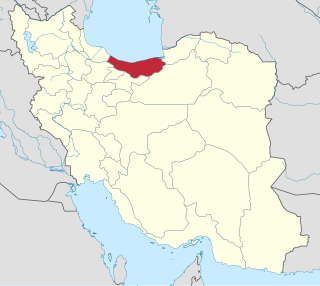
Mazandaran Province and, is an Iranian province located along the southern coast of the Caspian Sea and in the adjacent Central Alborz mountain range, in central-northern Iran.
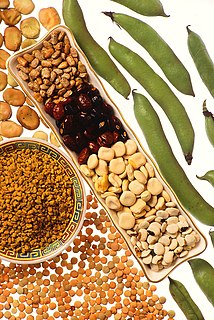
A legume is a plant in the family Fabaceae, or the fruit or seed of such a plant. When used as a dry grain, the seed is also called a pulse. Legumes are grown agriculturally, primarily for human consumption, for livestock forage and silage, and as soil-enhancing green manure. Well-known legumes include beans, soybeans, peas, chickpeas, peanuts, lentils, lupins, mesquite, carob, tamarind, alfalfa, and clover. Legumes produce a botanically unique type of fruit – a simple dry fruit that develops from a simple carpel and usually dehisces on two sides.
Abū Jaʿfar Muḥammad ibn Jarīr ibn Yazīd al-Ṭabarī, also known as al-Tabari or in Persian as Tabari, 839–923 CE, was an influential scholar, historian and commentator on the Qur'an from Amol, Tabaristan. Today, he is best known for his expertise in Qur'anic exegesis (tafsir) and Historiography, but he has been described as "an impressively prolific polymath. He wrote on such subjects as world history, poetry, lexicography, grammar, ethics, mathematics, and medicine."
Abu al-Hasan Ali ibn Sahl Rabban al-Tabari, was a Persian Muslim scholar, physician and psychologist, who produced one of the first encyclopedia of medicine titled Firdous al-Hikmah. Ali ibn Sahl spoke Syriac and Greek, the two sources of the medical tradition of Antiquity which had been lost by medieval Europe, and transcribed in meticulous calligraphy. His famous student Muhammad ibn Zakariya al-Razi has darkened his fame. He wrote the first encyclopedic work on medicine. He lived for over 70 years and interacted with important figures of the time, such as Muslim caliphs, governors, and eminent scholars. Because of his family's religious history, as well as his religious work, al-Tabarī was one of the most controversial scholars. He first discovered that the pulmonary tuberculosis was contagious.

A samosa is a fried or baked pastry with a savory filling, including ingredients such as spiced potatoes, onions, peas. It may take different forms, including triangular, cone, or half-moon shapes, depending on the region. Samosas are often accompanied by chutney, and have origins in medieval times or earlier. Samosas are a popular entrée, appetizer, or snack in the cuisines of South Asia, the Middle East, Central Asia, East Africa and their diasporas.
Traditionally, the various cuisines of Africa use a combination of plant and seed based, and do not usually have food imported. In some parts of the continent, the traditional diet features an abundance of root tuber products.

Arab cuisine is the cuisine of the Arabs, defined as the various regional cuisines spanning the Arab world, from the Maghreb to the Fertile Crescent and the Arabian Peninsula. These cuisines are centuries old and reflect the culture of trading in Baharat (spices), herbs, and foods. The regions have many similarities, but also unique traditions. They have also been influenced by climate, cultivation, and mutual commerce.
Armenian cuisine includes the foods and cooking techniques of the Armenian people and traditional Armenian foods and dishes. The cuisine reflects the history and geography where Armenians have lived as well as sharing outside influences from European and Levantine cuisines. The cuisine also reflects the traditional crops and animals grown and raised in Armenian populated areas.
Sahl ibn Bishr al-Israili, also known as Rabban al-Tabari and Haya al-Yahudi, was a Jewish Syriac Christian astrologer, astronomer and mathematician from Tabaristan. He was the father of Ali ibn Sahl the famous scientist and physician, who became a convert to Islam.

Emodin (6-methyl-1,3,8-trihydroxyanthraquinone) is a chemical compound, of the anthraquinone family, that can be isolated from rhubarb, buckthorn, and Japanese knotweed. Emodin is particularly abundant in the roots of the Chinese rhubarb, knotweed and knotgrass as well as Hawaii ‘au‘auko‘i cassia seeds or coffee weed. It is specifically isolated from Rheum Palmatum L. It is also produced by many species of fungi, including members of the genera Aspergillus, Pyrenochaeta, and Pestalotiopsis, inter alia. The common name is derived from Rheum emodi, a taxonomic synonym of Rheum australe, and synonyms include emodol, frangula emodin, rheum emodin, 3-methyl-1,6,8-trihydroxyanthraquinone, Schuttgelb, and Persian Berry Lake.
Yahya ibn Umar ibn Yahya ibn Husayn ibn Zayd ibn Ali Zayn al-Abidin ibn Al-Husayn ibn Ali was an Alid Imam. His mother was Umm al-Husayn Fatimah bint al-Husayn ibn Abdallah ibn Ismail ibn Abdullah ibn Ja`far ibn Abī Tālib. In the days of the Abbasid caliph Al-Musta'in, he marched out from Kufa and lead an abortive uprising from Kufa in 250 A.H., but was killed by the Abbasid forces led by Hussain ibn Isma’il, who had been sent to deal with him.

A grain is a small, hard, dry seed – with or without an attached hull or fruit layer – harvested for human or animal consumption. A grain crop is a grain-producing plant. The two main types of commercial grain crops are cereals and legumes.

Vada[vəɽɑː] or bada[bəɽɑː] is a category of savoury fried snacks from India. Different types of vadas can be described variously as fritters, cutlets, doughnuts, or dumplings. Alternative names for this food include wada, vade, vadai, wadeh and bara.

Pea soup or split pea soup is soup made typically from dried peas, such as the split pea. It is, with variations, a part of the cuisine of many cultures. It is most often greyish-green or yellow in color depending on the regional variety of peas used; all are cultivars of Pisum sativum.
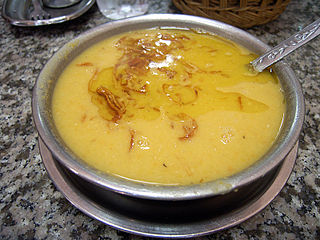
Lentil soup is a soup based on lentils; it may be vegetarian or include meat, and may use brown, red, yellow, green or black lentils, with or without the husk. Dehulled yellow and red lentils disintegrate in cooking, making a thick soup. It is a staple food throughout Europe, Latin America and the Middle East.
Glossostemon bruguieri or Dombeya arabica is a species of flowering plant in the family Malvaceae. It is a shrub with thick long tapering dark colored roots with 70–100 cm in length and 5–8 cm in breadth, found in Yemen, Iran, Iraq, Egypt, Saudi Arabia, Turkey and Morocco. The dried peeled roots of G. bruguieri are called in Egypt and Arab countries. The roots are commonly used in traditional medicine for many nutritional and medicinal values.












